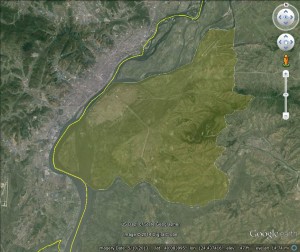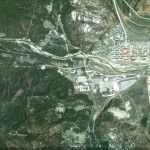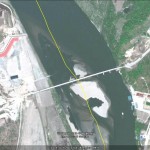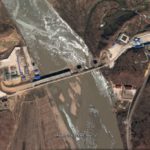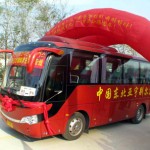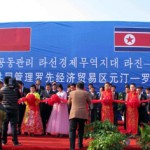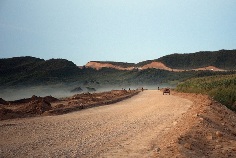According to KCNA:
Economic Development Zones to Be Set up in Provinces of DPRK
Pyongyang, July 23, 2014 17:50 KST (KCNA) — It was decided in the DPRK to establish economic development zones in some areas of Pyongyang, South Hwanghae Province, Nampho City, South and North Phyongan provinces.
Unjong cutting-edge technological development zone will be set up in some areas of Wisong-dong, Kwahak 1-dong and Kwahak 2-dong, Paesan-dong and Ulmil-dong in Unjong District, Pyongyang.
Kangryong international green model zone will be set up in some areas of Kangryong township in Kangryong County, South Hwanghae Province.
Jindo export processing zone will appear in some areas of Jindo-dong and Hwado-ri, Waudo District, Nampho City.
Chongnam industrial development zone will be set up in some areas of Ryongbuk-ri, Chongnam District, South Phyongan Province. Sukchon agricultural development zone will appear in some areas of Unjong-ri, Sukchon County and Chongsu tourist development zone in some areas of Chongsong Workers’ District and Pangsan-ri, Sakju County, North Phyongan Province.
The sovereignty of the DPRK would be exercised in the economic development zones in provinces.
The relevant decree of the Presidium of the Supreme People’s Assembly was promulgated on Wednesday.
By my count, this brings the total number of special economic zones and economic development zones to 25. Little visible progress has been made on the zones announced in 2013, though things seem to be happening in Pyongyang. Also, South Phyongan Province now has Economic Development Zones. It had been omitted from previous lists.
Yonhap also reports:
Jin Qiangyi, a professor of Korean studies at Yanbian University, told the state-run China Daily that the move by North Korea is apparently aimed at breathing new life into its moribund economy.
…
“Many Chinese companies still feel daunted by doing business in the country because there is no clear policy to guarantee investors’ interests,” the newspaper quoted Jin as saying.
However, another Chinese expert, Li Tianguo, a researcher at the National Institute of International Strategy at the Chinese Academy of Social Sciences, was less pessimistic.
Li told the newspaper that the new zones will “have great attraction to Chinese enterprise and bring good opportunities, in particular for businesses with border trade and processing production.”
China’s direct investment into North Korea jumped to US$109.46 million in 2012 from $5.86 million in 2009, the newspaper reported, citing what it called a “2012 Statistical Bulletin of China’s Outward Foreign Direct Investment.”
Here is analysis by the Institute for Far Eastern Studies (IFES):
North Korea Declares Six Additional Economic Development Zones
On July 23, 2014, the (North) Korean Central News Agency (KCNA) announced the designation of six additional economic development zones (EDZs) throughout various provinces in North Korea. The announcement, which states, “It was decided in the DPRK to establish economic development zones in some areas of Pyongyang, South Hwanghae Province, Nampo City, South and North Pyongan Provinces,” and that this decree was promulgated by the Presidium of the Supreme People’s Assembly (SPA).
It was announced that North Korea will push forward with the Unjong Cutting-Edge Technological Development Zone in the areas of Wisong, Kwahak 1 and 2, Paesan and Ulmil, located in the Unjong District of Pyongyang. Furthermore, it appears that the Kangryong International Green Model Zone will be established in Kangryong County in South Hwanghae Province. According to the investment propositions revealed in November 2013, the “International Green Model Zone” will focus on the development of organic farming and greenhouse technology, wind and water power technology, and the development of services such as golf courses and hotels.
The Chongnam Industrial Development Zone will be set up in Chongnam District in South Pyongan Province, Sukchon Agricultural Development Zone will be established in various areas in Unjong in Sukchon County, and the Chongsu Tourist Development Zone will cover the areas of the Chongsong Workers’ District and Pangsan, Sakju County in North Pyongan Province. It has also been reported that North Korea will push forward with the Jindo Export Processing Zone in Jindo and Hwado, located in the Waudo District of Nampo City. Following the announcement of thirteen new economic development zones in November last year, including the Amrok (Yalu) River EDZ, Sinpyeong Tourism Development Zone, the Manpo EDZ and Wiwon Industrial Development Zone, the newly announced six additional zones brings the total number of economic development zones in North Korea to nineteen.
It was also reported by the KCNA on the same day that the Sinuiju Special Economic Zone in Sinuiju, North Pyongan Province, will be renamed to the Sinuiju International Economic Zone. Through this renaming, it can be assumed that North Korea is intending to reinitiate development in the stagnating zone, which has been in the development process since first being designated as a special economic zone in 2002.
On the other hand, the Wonsan Kalma Peninsula in North Korea’s Kangwondo Province, renowned for its beautiful scenery, has been garnering attention due to a recent push for the construction of large-scale accommodation, recreation and industrial facilities. Over 1,400 ha plot of land along the Kalma Peninsula is expected to be divided up into several areas, including hotels and accommodations, conference and exhibit fairgrounds, an athletics stadium, economic development area, and a commerce service area.
In order to respond to the increase in tourists visiting the Wonsan area, North Korea is preparing to increase the area’s hotel and lodging capacity by ten times, maxing out at a total capacity of eleven thousand people. Furthermore, plans have been drawn up calling for the construction of a passenger wharf which can transport up to twenty-five thousand people per day to the waterfront. The beach area will also be developed, allowing for up to ten thousand beachgoers at one time.
In the Dunam Mountain area of Kalma Peninsula, theaters, golf courses, an underwater hotel, and tourist accommodations will be built together with industrial complexes for science, industry and agricultural research and development. It is also predicted that North Korea will also develop several of the small islands off the coast of the Kalma Peninsula into tourist attractions.
I have all of the economic Development Zones mapped out on Google Earth.

